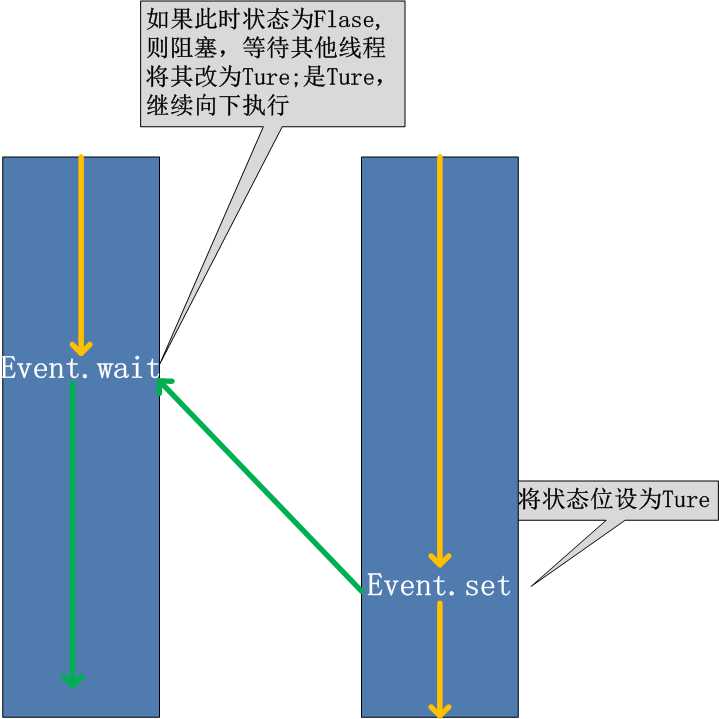标签:级别 运行 英文 对象 通知 ems greenlet 计算 less
异步调用与回调机制
在之前我们有了解过异步调用机制,当我们在发起异步调用后,并不会等待任务结束才返回,而是直接执行下一行代码,如果异步功能用状态来通知,那么调用者就需要每隔一定时间检查一次,效率就很低,如果是使用通知的方式,效率则很高,因为异步功能几乎不需要做额外的操作。至于回调函数,其实和通知没太多区别。
#举例:
#1. multiprocessing.Pool().apply_async() #发起异步调用后,并不会等待任务结束才返回,相反,会立即获取一个临时结果(并不是最终的结果,可能是封装好的一个对象)。
#2. concurrent.futures.ProcessPoolExecutor(3).submit(func,)
#3. concurrent.futures.ThreadPoolExecutor(3).submit(func,)

from concurrent.futures import ProcessPoolExecutor,ThreadPoolExecutor
from threading import current_thread
import requests
import os
import time
import random
def get(url):
print(‘%s GET %s‘ %(current_thread().name,url))
response=requests.get(url)
time.sleep(random.randint(1,3))
if response.status_code == 200:
# 干解析的活
return response.text
def pasrse(obj):
res=obj.result()
print(‘%s 解析结果为:%s‘ %(current_thread().name,len(res)))
if __name__ == ‘__main__‘:
urls=[
‘https://www.baidu.com‘,
‘https://www.baidu.com‘,
‘https://www.baidu.com‘,
‘https://www.baidu.com‘,
‘https://www.baidu.com‘,
‘https://www.baidu.com‘,
‘https://www.baidu.com‘,
‘https://www.baidu.com‘,
‘https://www.python.org‘,
]
pool=ThreadPoolExecutor(4)
for url in urls:
obj=pool.submit(get,url)
obj.add_done_callback(pasrse)
print(‘主线程‘,current_thread().name)
线程queue
queue队列 :使用import queue,用法与进程Queue一样
queue is especially useful in threaded programming when information must be exchanged safely between multiple threads.
class queue.Queue(maxsize=0) #先进先出

import queue
q=queue.Queue()
q.put(‘first‘)
q.put(‘second‘)
q.put(‘third‘)
print(q.get())
print(q.get())
print(q.get())
‘‘‘
结果(先进先出):
first
second
third
‘‘‘
class queue.LifoQueue(maxsize=0) #last in fisrt out

import queue
q=queue.LifoQueue()
q.put(‘first‘)
q.put(‘second‘)
q.put(‘third‘)
print(q.get())
print(q.get())
print(q.get())
‘‘‘
结果(后进先出):
third
second
first
‘‘‘
class queue.PriorityQueue(maxsize=0) #存储数据时可设置优先级的队列

import queue
q=queue.PriorityQueue()
#put进入一个元组,元组的第一个元素是优先级(通常是数字,也可以是非数字之间的比较),数字越小优先级越高
q.put((20,‘a‘))
q.put((10,‘b‘))
q.put((30,‘c‘))
print(q.get())
print(q.get())
print(q.get())
‘‘‘
结果(数字越小优先级越高,优先级高的优先出队):
(10, ‘b‘)
(20, ‘a‘)
(30, ‘c‘)
‘‘‘

Constructor for a priority queue. maxsize is an integer that sets the upperbound limit on the number of items that can be placed in the queue. Insertion will block once this size has been reached, until queue items are consumed. If maxsize is less than or equal to zero, the queue size is infinite.
The lowest valued entries are retrieved first (the lowest valued entry is the one returned by sorted(list(entries))[0]). A typical pattern for entries is a tuple in the form: (priority_number, data).
exception queue.Empty
Exception raised when non-blocking get() (or get_nowait()) is called on a Queue object which is empty.
exception queue.Full
Exception raised when non-blocking put() (or put_nowait()) is called on a Queue object which is full.
Queue.qsize()
Queue.empty() #return True if empty
Queue.full() # return True if full
Queue.put(item, block=True, timeout=None)
Put item into the queue. If optional args block is true and timeout is None (the default), block if necessary until a free slot is available. If timeout is a positive number, it blocks at most timeout seconds and raises the Full exception if no free slot was available within that time. Otherwise (block is false), put an item on the queue if a free slot is immediately available, else raise the Full exception (timeout is ignored in that case).
Queue.put_nowait(item)
Equivalent to put(item, False).
Queue.get(block=True, timeout=None)
Remove and return an item from the queue. If optional args block is true and timeout is None (the default), block if necessary until an item is available. If timeout is a positive number, it blocks at most timeout seconds and raises the Empty exception if no item was available within that time. Otherwise (block is false), return an item if one is immediately available, else raise the Empty exception (timeout is ignored in that case).
Queue.get_nowait()
Equivalent to get(False).
Two methods are offered to support tracking whether enqueued tasks have been fully processed by daemon consumer threads.
Queue.task_done()
Indicate that a formerly enqueued task is complete. Used by queue consumer threads. For each get() used to fetch a task, a subsequent call to task_done() tells the queue that the processing on the task is complete.
If a join() is currently blocking, it will resume when all items have been processed (meaning that a task_done() call was received for every item that had been put() into the queue).
Raises a ValueError if called more times than there were items placed in the queue.
Queue.join() block直到queue被消费完毕
线程Event
同进程的一样
线程的一个关键特性是每个线程都是独立运行且状态不可预测。如果程序中的其 他线程需要通过判断某个线程的状态来确定自己下一步的操作,这时线程同步问题就会变得非常棘手。为了解决这些问题,我们需要使用threading库中的Event对象。 对象包含一个可由线程设置的信号标志,它允许线程等待某些事件的发生。在 初始情况下,Event对象中的信号标志被设置为假。如果有线程等待一个Event对象, 而这个Event对象的标志为假,那么这个线程将会被一直阻塞直至该标志为真。一个线程如果将一个Event对象的信号标志设置为真,它将唤醒所有等待这个Event对象的线程。如果一个线程等待一个已经被设置为真的Event对象,那么它将忽略这个事件, 继续执行
event.isSet():返回event的状态值;
event.wait():如果 event.isSet()==False将阻塞线程;
event.set(): 设置event的状态值为True,所有阻塞池的线程激活进入就绪状态, 等待操作系统调度;
event.clear():恢复event的状态值为False。


from threading import Thread,Event
import threading
import time,random
def conn_mysql():
count=1
while not event.is_set():
if count > 3:
raise TimeoutError(‘链接超时‘)
print(‘<%s>第%s次尝试链接‘ % (threading.current_thread().getName(), count))
event.wait(0.5)
count+=1
print(‘<%s>链接成功‘ %threading.current_thread().getName())
def check_mysql():
print(‘\033[45m[%s]正在检查mysql\033[0m‘ % threading.current_thread().getName())
time.sleep(random.randint(2,4))
event.set()
if __name__ == ‘__main__‘:
event=Event()
conn1=Thread(target=conn_mysql)
conn2=Thread(target=conn_mysql)
check=Thread(target=check_mysql)
conn1.start()
conn2.start()
check.start()
协程
协程:是单线程下的并发,又称微线程,纤程。英文名Coroutine。一句话说明什么是线程:协程是一种用户态的轻量级线程,即协程是由用户程序自己控制调度的。
协程主要就是以单线程来实现高并发,就是使用一个主线程,可以利用的CPU资源只有一个,而我们所了解的并发的本质就是:切换+保存状态
cpu正在运行一个任务,会在两种情况下切走去执行其他的任务(切换由操作系统强制控制),一种情况是该任务发生了阻塞,另外一种情况是该任务计算的时间过长或有一个优先级更高的程序替代了它
其中第二种情况并不能提升效率,只是为了让cpu能够雨露均沾,实现看起来所有任务都被“同时”执行的效果,如果多个任务都是纯计算的,这种切换反而会降低效率。
我们可以基于yeird来验证:
#1 yiled可以保存状态,yield的状态保存与操作系统的保存线程状态很像,但是yield是代码级别控制的,更轻量级
#2 send可以把一个函数的结果传给另外一个函数,以此实现单线程内程序之间的切换

#串行执行
import time
def consumer(res):
‘‘‘任务1:接收数据,处理数据‘‘‘
pass
def producer():
‘‘‘任务2:生产数据‘‘‘
res=[]
for i in range(10000000):
res.append(i)
return res
start=time.time()
#串行执行
res=producer()
consumer(res) #写成consumer(producer())会降低执行效率
stop=time.time()
print(stop-start) #1.5536692142486572
#基于yield并发执行
import time
def consumer():
‘‘‘任务1:接收数据,处理数据‘‘‘
while True:
x=yield
def producer():
‘‘‘任务2:生产数据‘‘‘
g=consumer()
next(g)
for i in range(10000000):
g.send(i)
start=time.time()
#基于yield保存状态,实现两个任务直接来回切换,即并发的效果
#PS:如果每个任务中都加上打印,那么明显地看到两个任务的打印是你一次我一次,即并发执行的.
producer()
stop=time.time()
print(stop-start) #2.0272178649902344
第一种情况的切换。在任务一遇到io情况下,切到任务二去执行,这样就可以利用任务一阻塞的时间完成任务二的计算,效率的提升就在于此。

import time
def consumer():
‘‘‘任务1:接收数据,处理数据‘‘‘
while True:
x=yield
def producer():
‘‘‘任务2:生产数据‘‘‘
g=consumer()
next(g)
for i in range(10000000):
g.send(i)
time.sleep(2)
start=time.time()
producer() #并发执行,但是任务producer遇到io就会阻塞住,并不会切到该线程内的其他任务去执行
stop=time.time()
print(stop-start)
yield并不能实现遇到io切换
对于单线程下,我们不可避免程序中出现io操作,但如果我们能在自己的程序中(即用户程序级别,而非操作系统级别)控制单线程下的多个任务能在一个任务遇到io阻塞时就切换到另外一个任务去计算,这样就保证了该线程能够最大限度地处于就绪态,即随时都可以被cpu执行的状态,相当于我们在用户程序级别将自己的io操作最大限度地隐藏起来,从而可以迷惑操作系统,让其看到:该线程好像是一直在计算,io比较少,从而更多的将cpu的执行权限分配给我们的线程。
协程的本质就是在单线程下,由用户自己控制一个任务遇到io阻塞了就切换另外一个任务去执行,以此来提升效率。
#1. python的线程属于内核级别的,即由操作系统控制调度(如单线程遇到io或执行时间过长就会被迫交出cpu执行权限,切换其他线程运行)
#2. 单线程内开启协程,一旦遇到io,就会从应用程序级别(而非操作系统)控制切换,以此来提升效率(!!!非io操作的切换与效率无关)
对比操作系统控制线程的切换,用户在单线程内控制协程的切换
优点如下:
#1. 协程的切换开销更小,属于程序级别的切换,操作系统完全感知不到,因而更加轻量级
#2. 单线程内就可以实现并发的效果,最大限度地利用cpu
缺点如下:
#1. 协程的本质是单线程下,无法利用多核,可以是一个程序开启多个进程,每个进程内开启多个线程,每个线程内开启协程
#2. 协程指的是单个线程,因而一旦协程出现阻塞,将会阻塞整个线程
总结协程特点:
在python当中其实并没有协程这个属性,而是程序员们默认的将单线程下的并发叫做协程

from gevent import monkey;monkey.patch_all()
from threading import current_thread
import gevent
import time
def eat():
print(‘%s eat 1‘ %current_thread().name)
time.sleep(5)
print(‘%s eat 2‘ %current_thread().name)
def play():
print(‘%s play 1‘ %current_thread().name)
time.sleep(3)
print(‘%s play 2‘ %current_thread().name)
g1=gevent.spawn(eat)
g2=gevent.spawn(play)
# gevent.sleep(100)
# g1.join()
# g2.join()
print(current_thread().name)
gevent.joinall([g1,g2])
标签:级别 运行 英文 对象 通知 ems greenlet 计算 less
原文地址:https://www.cnblogs.com/Yang-Sen/p/8968407.html